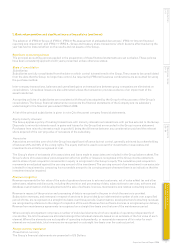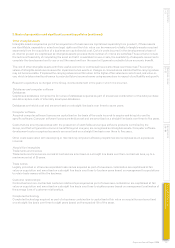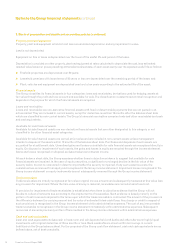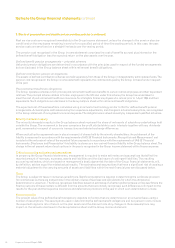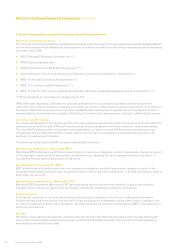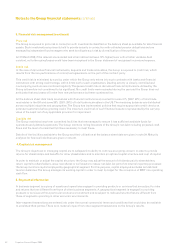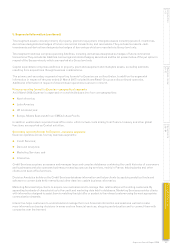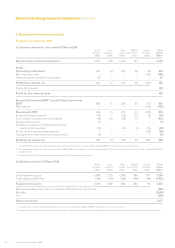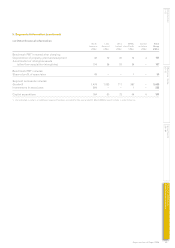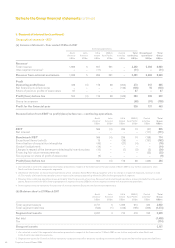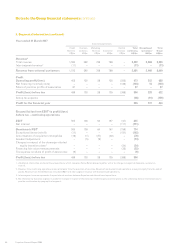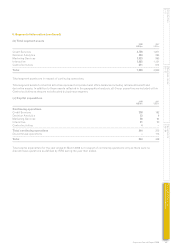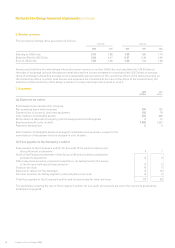Experian 2008 Annual Report Download - page 83
Download and view the complete annual report
Please find page 83 of the 2008 Experian annual report below. You can navigate through the pages in the report by either clicking on the pages listed below, or by using the keyword search tool below to find specific information within the annual report.
81Experian Annual Report 2008
Introduction
2 – 5
Business review
6 – 37
Governance
38 – 64
Financial statements
Group financial statements
Financial statements
Group financial statements
3. Financial risk management
The Group’s activities expose it to a variety of financial risks: market risk (including foreign exchange risk, interest rate
risk and price risk), credit risk and liquidity risk. The Group’s financial risk management focuses on the unpredictability of
financial markets and seeks to minimise potential adverse effects on the Group’s financial performance. The Group seeks to
reduce its exposure to financial risks and uses derivative financial instruments to hedge certain risk exposures.The Group
also ensures surplus funds are managed and controlled in a prudent manner which will protect capital sums invested and
ensure adequate short-term liquidity, whist maximising returns.
Prior to the demerger in October 2006, the Group transacted primarily in Sterling. The hedging and risk management
strategies pursued for the years then ended reflected this. Policies adopted since demerger reflect the increased significance
of the Group’s US Dollar operations.
Market risk
Foreign exchange risk
The Group operates internationally and is exposed to foreign exchange risk from future commercial transactions, recognised
assets and liabilities and investments in, and loans between, entities with different functional currencies. The Group
manages such risk, primarily within entities whose functional currencies are Sterling, by borrowing in the relevant foreign
currencies and using forward foreign exchange contracts. The principal transaction exposures are to the US Dollar and
the Euro.
The Group has investments in entities with other functional currencies, whose net assets are exposed to foreign exchange
translation risk. In order to reduce the impact of currency fluctuations on the value of such entities, the Group has a policy
of borrowing in US Dollars and Euros, as well as in Sterling and of entering into forward foreign exchange contracts in the
relevant currencies.
At 31 March 2008, if the US Dollar had strengthened/weakened by 6% (2007: 8%) against Sterling, with all other variables held
constant, profit for the financial year would have been US$1m (2007: n/a) higher/lower, and other components of equity would
have been unchanged.
At 31 March 2008, if the Euro had strengthened/weakened by 3% (2007: 2%) against Sterling, with all other variables held
constant, profit for the financial year would have been unchanged (2007: US$1m higher/lower), and other components of
equity would have been unchanged.
Interest rate risk
The Group’s interest rate risk arises principally from its net debt and the portions thereof at variable rates which expose the
Group to such risk.
The Group has a policy of normally maintaining between 30% and 70% of net debt at rates that are fixed for more than one
year. The Group’s interest rate exposure is managed by the use of fixed and floating rate borrowings and by the use of interest
rate swaps to adjust the balance of fixed and floating rate liabilities. The Group also mixes the duration of its borrowings to
smooth the impact of interest rate fluctuations.
At 31 March 2008, if interest rates on US Dollar denominated net debt had been 1.4% (2007: 1.4%) higher/lower with all other
variables held constant, profit for the financial year would have been US$8m (2007: US$12m) lower/higher, mainly as a result
of higher/lower interest on deposits and floating rate borrowings.
At 31 March 2008, if interest rates on Sterling denominated net debt had been 0.4% (2007: 0.4%) higher/lower with all other
variables held constant, profit for the financial year would have been US$8m (2007: US$8m) lower/higher, mainly as a result of
higher/lower interest on deposits and floating rate borrowings.
At 31 March 2008, if interest rates on Brazilian Real denominated net debt had been 2.4% (2007: 1.2%) higher/lower, with all
other variables held constant, profit for the financial year would have been US$1m (2007: n/a) lower/higher, mainly as a result
of higher/lower interest on deposits and floating rate borrowings.
At 31 March 2008, if interest rates on Euro denominated net debt had been 0.7% (2007: 0.4%) higher/lower with all other
variables held constant, profit for the financial year would have been US$3m (2007: US$1m) lower/higher, mainly as a result of
higher/lower interest on deposits and floating rate borrowings.


